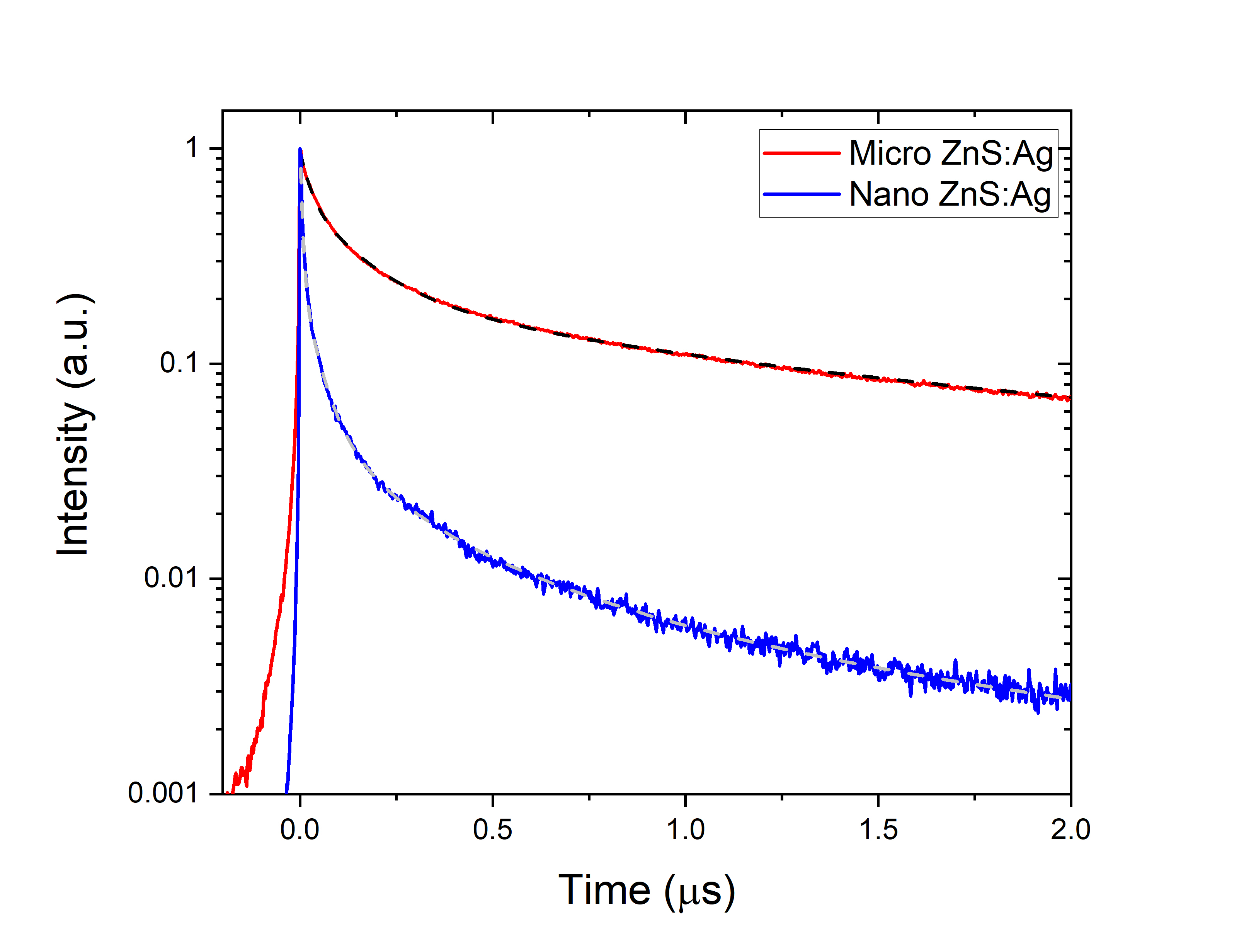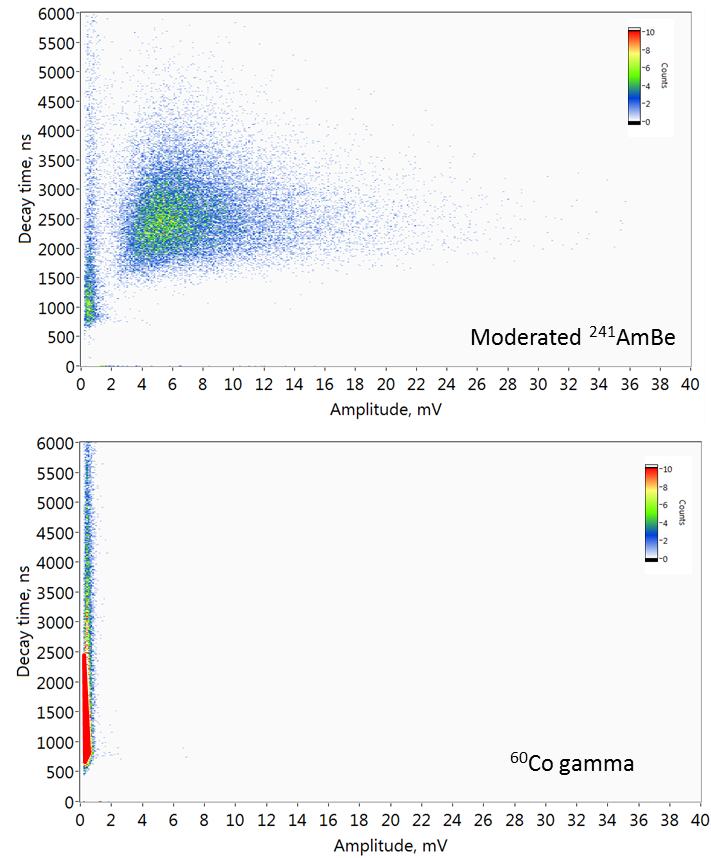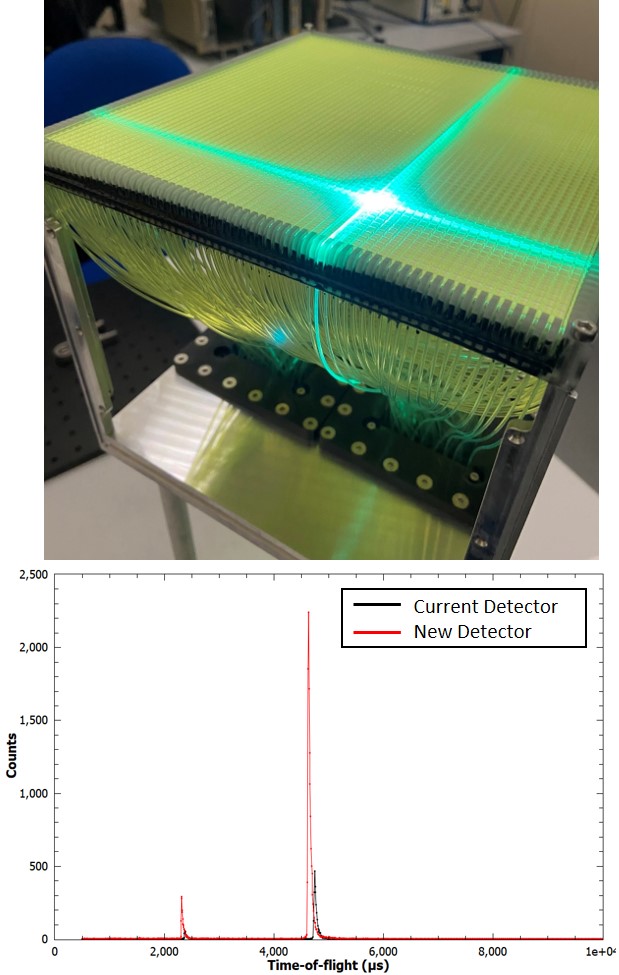Recent Scientific Highlights
Novel nanoparticle ZnS:Ag scintillators
The ZnS:Ag scintillator currently used in almost all of the scintillation detectors at ISIS is limited by a long lifetime afterglow due its complex defect structure trapping electrons. De-trapping and subsequent light emission is thought to occur through quantum tunneling

of the electron to recombination centres. Decay time of the nanoparticle scintillator would therefore benefit from both highly localised electrons and holes and also removing the long afterglow processes. Understanding and taking advantage of the luminescence of nanoparticle ZnS:Ag is therefore a major step toward higher count rate capable detectors.
The figure to the left demonstrates the measured improvements in scintillation decay time from the synthesised nanoparticle ZnS:Ag compared to the standard commercially available ZnS:Ag scintillator. The primary decay of the nanoparticles is comparable to the measurement limitations and at 15x faster than the commercial while the time to 1% is over a factor 20 faster demonstrating real promise for future detectors.
Publications:
S. E. Mann, E. M. Schooneveld, N. J. Rhodes, D. Liu and G. J. Sykora, Timing properties of radioluminescence in nanoparticle ZnS:Ag scintillators, Optical Materials: X, 17 (2023) 100226. https://doi.org/10.1016/j.omx.2022.100226
ZnO:Zn - a low afterglow alternative to ZnS:Ag

ZnO:Zn is a material used in electro-luminescent displays that emits bright green light under photo- and high energy electron excitation. Until now, the scintillation mechanisms of ZnO:Zn have been relatively unknown, however the photoluminescence was known to decay faster than that of ZnS:Ag. Experimental studies at ISIS have shown that, not only does ZnO:Zn exhibit bright scintillation with no long-lifetime afterglow, but also has pulse shape discrimination between neutrons and gammas allowing effective gamma rejection. Luminescent properties of this material are being thoroughly studied and applied to to functioning position sensitive neutron detectors with higher count rate capabilities than conventional ZnS:Ag detectors.
The figure to the right is a 2D histogram of radiation interaction events, with scintillation decay time on the vertical axis and overall lightoutput (amplitude) on the horizontal axis, showing the ability of ZnO:Zn to distinguish between neutrons and gammas where neutron induced signals are seen as the large "island" and the gamma signals appear as a vertical line near the vertical axis. ZnO:Zn is currently being investigated in a variety of detector geometries to see how it can impact the ISIS science programme.
Publications:
G. J. Sykora, E. M. Schooneveld and N. J. Rhodes, ZnO:Zn/6LiF scintillator—A low afterglow alternative to ZnS:Ag/6LiF for thermal neutron detection, Nucl. Instrum. Methods Phys. Res. A. 883 (2018) 75-82. https://doi.org/10.1016/j.nima.2017.11.052
Enhanced position resolution utlising new position reconstruction algorithms
Conventional wavelength shifting fibre detectors are made position sensitive by determining which fibre emits the most light in an individual neutron absorption event. This means that position resolution and positioning accuracy of the detector is determined by the fibre spacing within the detector. Through a thorough analysis of both measurements and modelling of light scattering and absorption in the scintillator material, we have optimised a position reconstruction algorithm which allows us to accurately locate the neutron absorption event at least 2 times (and in some instances, 4 times) better than the spacing between fibres. This algorithm has been extended to work with 2-dimensional (spatially) detectors, works in real-time on the same field programmable gate array (FPGA) currently used to process detector signals without loss of counting rate capability. This development has huge impact by allowing more complex structures to be studied or detectors to be built for much less cost with the same or better performance.
The figure below shows the position reconstruction algorithm being able to separate three closely located peaks on top of a structured background. The left plot shows the results using conventional positioning and the right shows the results using the new position reconstruction algorithm.

Publications:
G. Mauri, G. J. Sykora, E. M. Schooneveld and N. J. Rhodes, Enhanced position resolution for ZnS:Ag/6LiF wavelength shifting fibre thermal neutron detectors, Eur. Phys. J. Plus. 136 (2021) 286. https://doi.org/10.1140/epjp/s13360-021-01215-3
High efficiency 2-Dimensional detectors for single crystal diffraction

Over the past 20 years, single crystal diffraction on ISIS has been limited due to low efficiency neutron detectors. While the detectors on SXD have been cost effective and reliable, a new solution was needed to allow more complex crystals with larger unit cells to be measured. The scintillator development team worked out a way to increase the thermal neutron detection efficiency by a factor of 5 over the current SXD detectors putting the efficiency on par with "gold standard" 3He tubes. In depth knowledge of the scintillator, light collection mechanisms and signal processing techniques allowed us to construct a prototype detector without the need for extra electronics channels therefore gaining the factor of 5 in efficiency for very little increase in cost. In addition to this, by applying the position reconstruction method mentioned above, the detector can be easily made to have 4x better position resolution than the current detectors resulting in a breakthrough for single crystal diffraction at ISIS. An advanced prototype is now installed on SXD and a paper is in preparation.
The figure to the left (top) shows the detector under cronstruction with a blue laser pen shining on one spot to demonstrate the basic light collection principle and (bottom) data from the same diffraction peak from a NaCl crystal on the new detector and the old detector.
The scintillator development team have many more exciting research and development projects.
To find out more, contact Jeff Sykora, Giacomo Mauri or Sarah Mann.
